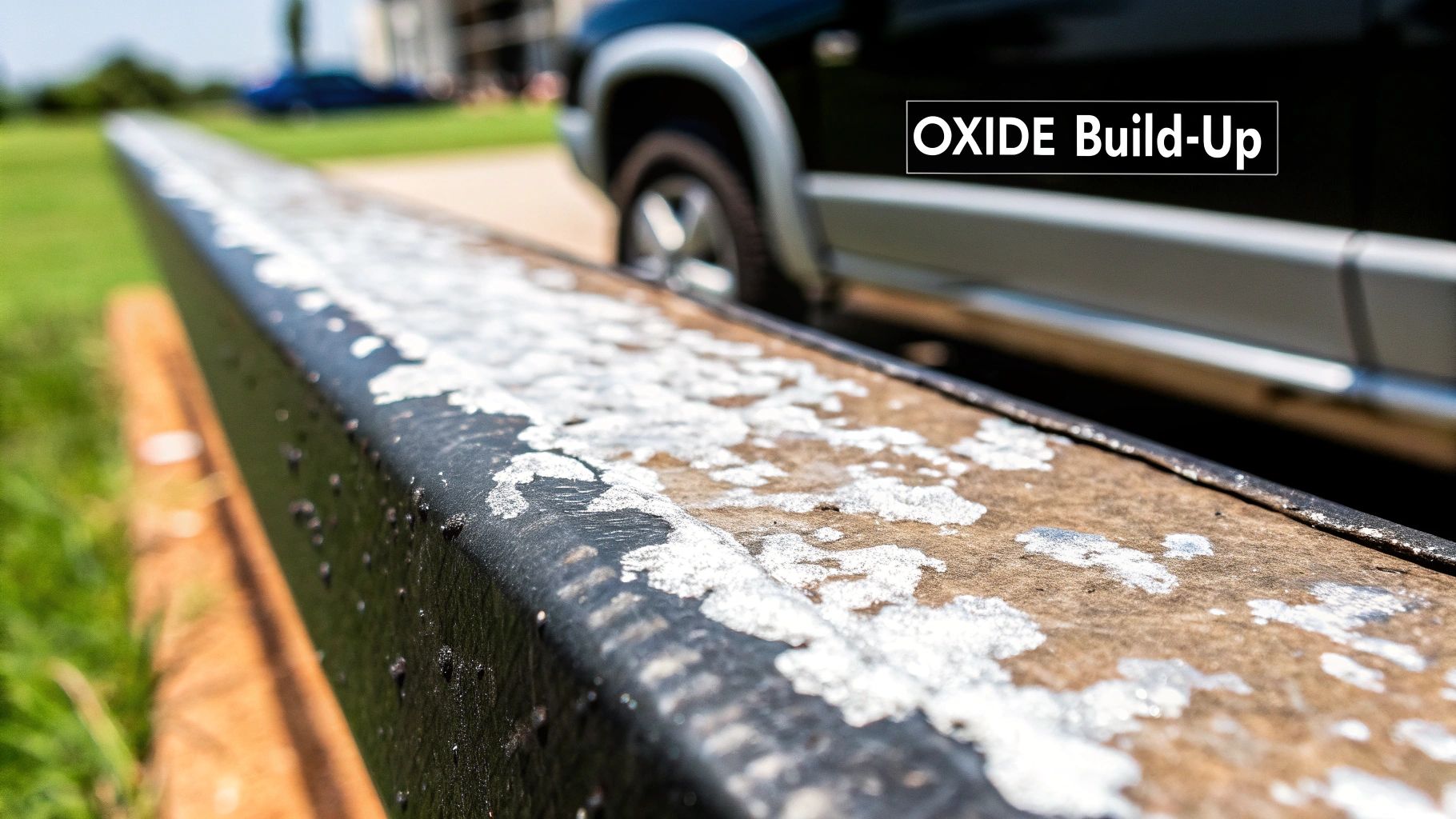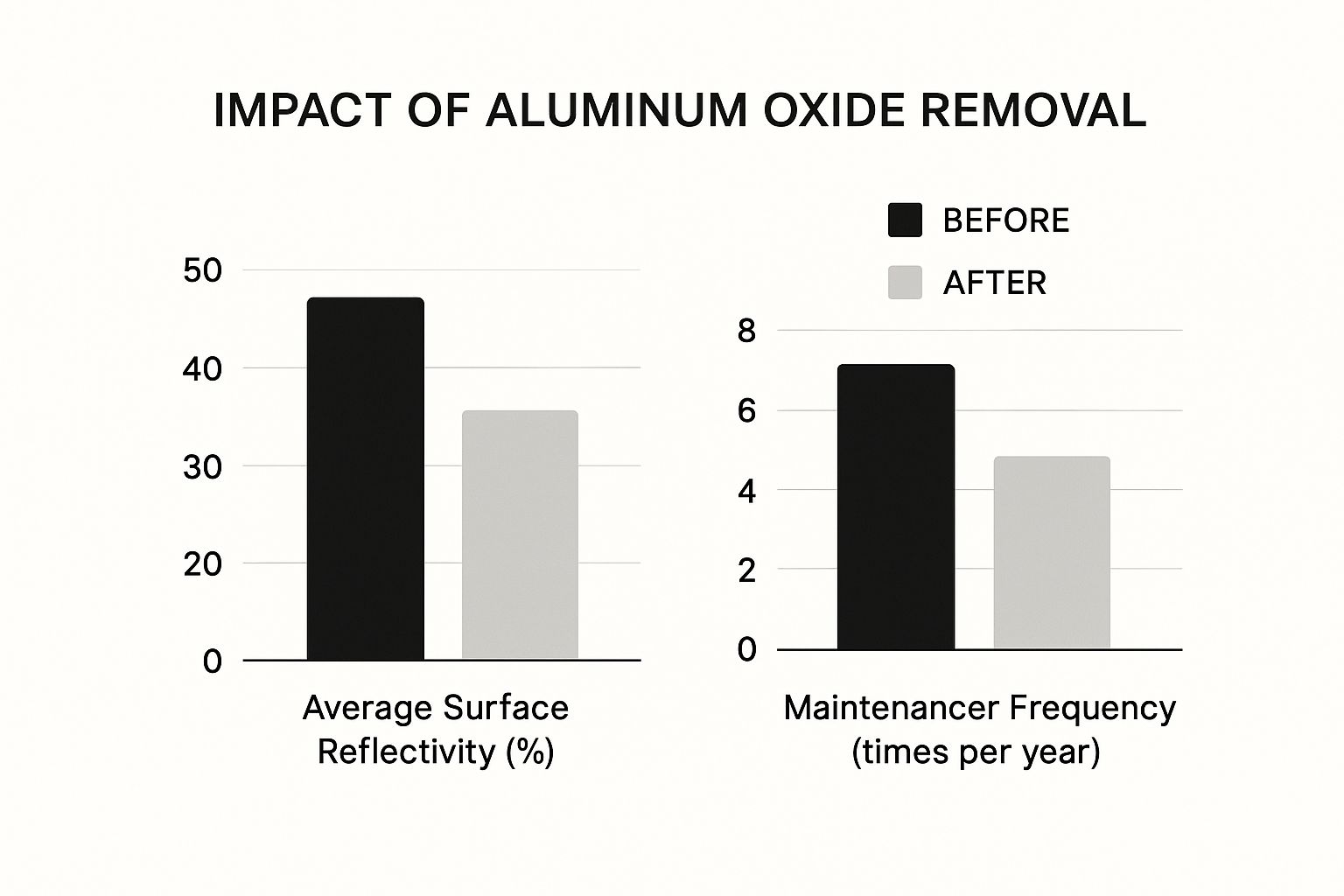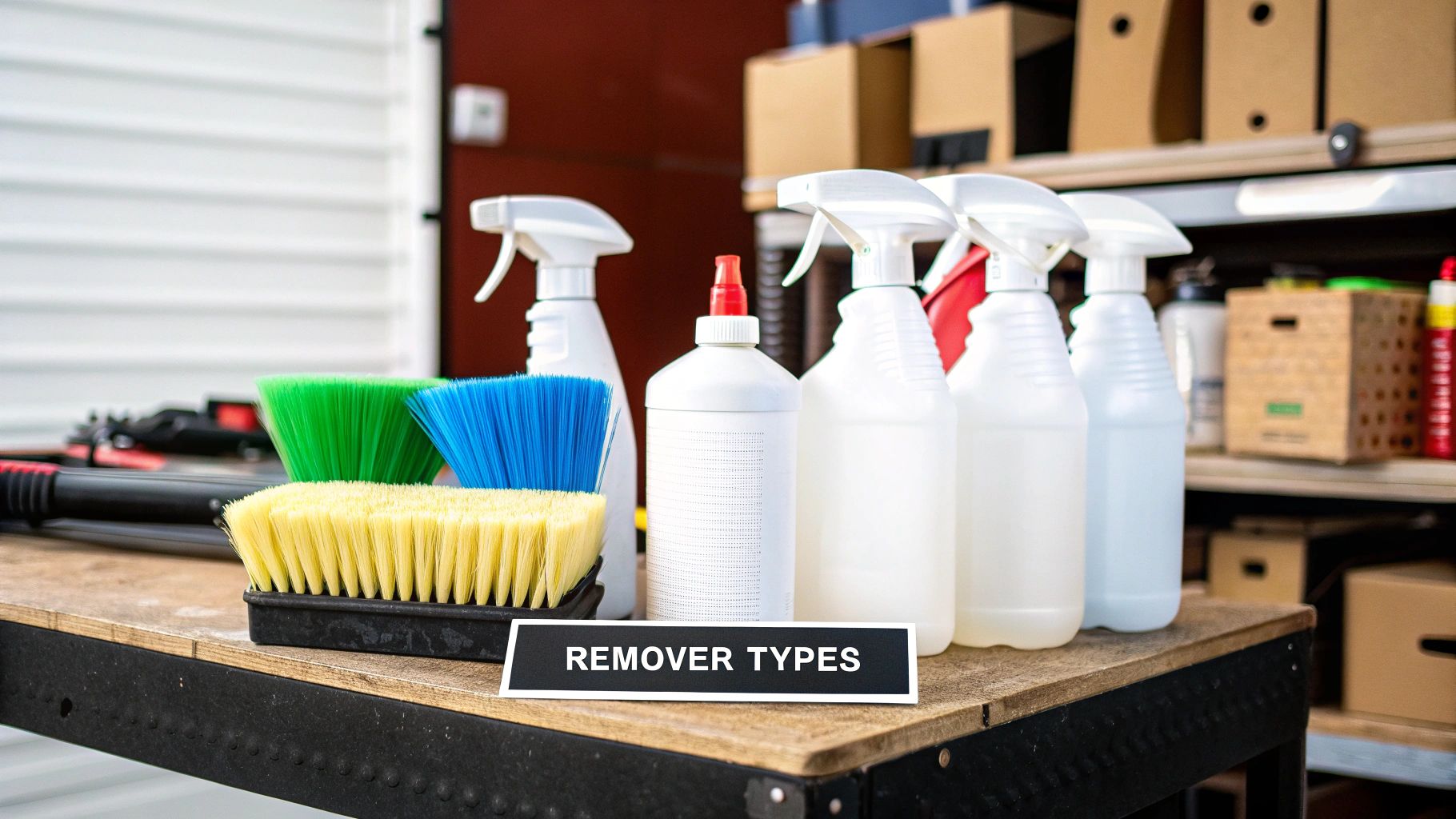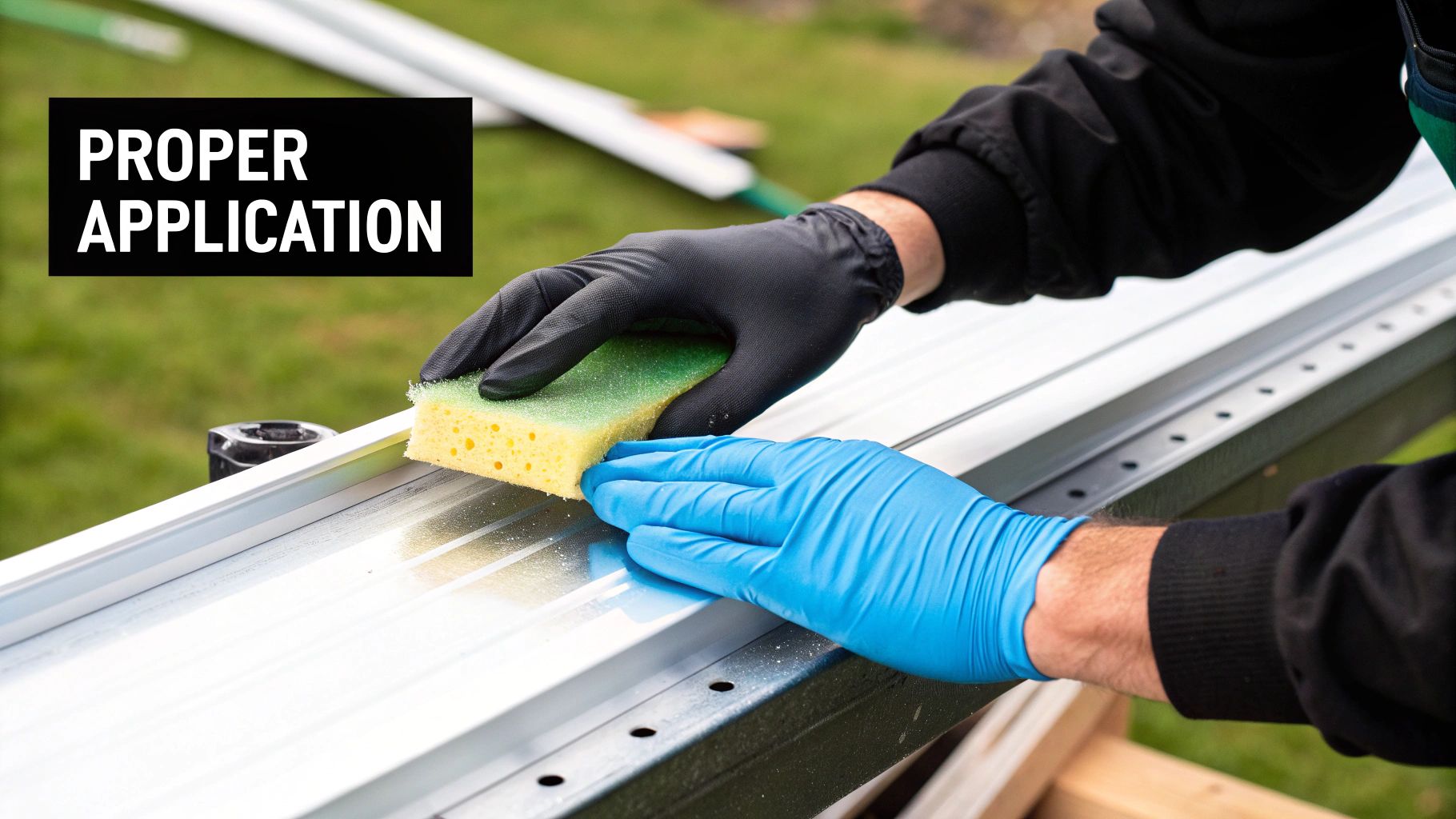Aluminum Oxide Remover Guide for Industrial Use
- Laserverse

- May 19
- 11 min read
The Hidden Impact of Aluminum Oxide on Industrial Performance
Aluminum oxide, that persistent white layer on aluminum surfaces, is often mistaken for a simple cosmetic issue. However, this misconception can have significant consequences for industrial operations. This seemingly harmless layer can interfere with critical processes, affecting everything from bonding and welding to finishing and overall component performance. Let's examine why aluminum's natural protector can become an industrial hindrance.
Aluminum oxide forms naturally when aluminum reacts with oxygen in the air. This reaction creates a protective barrier against further corrosion. However, environmental factors, particularly in areas like coastal California with its humidity, or even desert regions with their intense heat, can accelerate this oxidation process. This leads to a thicker, more problematic buildup. This buildup isn't just unsightly; it indicates a compromised surface that can disrupt various industrial applications.
How Aluminum Oxide Affects Industrial Processes
The impact of excessive aluminum oxide buildup manifests itself in several key ways:
Compromised Bonding: The oxide layer prevents adhesives and coatings from adhering correctly to the aluminum surface, resulting in weak bonds that fail prematurely.
Welding Difficulties: Aluminum oxide has a significantly higher melting point than aluminum. This difference creates inconsistencies during welding, potentially causing weak welds and structural defects.
Finishing Issues: The oxide layer can interfere with the application of paints, powder coatings, and other finishes, leading to uneven coverage and a less-than-ideal aesthetic.
Reduced Electrical Conductivity: In electrical applications, the oxide layer acts as an insulator, impeding current flow and possibly causing performance problems.
For instance, in the aerospace industry, even a microscopic layer of aluminum oxide can compromise the structural integrity of aircraft components. Similarly, in electronics manufacturing, particularly prevalent in California, oxide buildup can cause faulty connections and device malfunctions. These real-world examples highlight the importance of effective aluminum oxide removal. This market is experiencing rapid growth, with the global market size projected to rise from USD 6.1 billion in 2023 to USD 9.38 billion by 2032. California's strong industrial sectors, such as aerospace and automotive, contribute considerably to this demand. Find more detailed statistics here.
Addressing the Oxide Challenge
Recognizing the negative effects of aluminum oxide is the first step in mitigating its impact. Effective aluminum oxide removers are crucial for maintaining optimal industrial performance. Implementing preventative measures can also help control the oxidation rate. For those interested in online content creation, WordPress is a popular platform. These strategies, along with regular maintenance, will contribute to better product quality, increased efficiency, and lower operational costs. In the following sections, we’ll explore different removal methods, examining both chemical and mechanical solutions.

Chemical Solutions That Actually Dissolve Tough Oxide Layers
Not all aluminum oxide removers are created equal. Choosing the right one depends on understanding the chemical reactions involved. This means going beyond simple surface cleaning and considering how different formulas interact with the oxide layer itself, dissolving it without harming the underlying aluminum. This is critical for everything from cleaning sensitive electronics to maintaining heavy industrial equipment.
Matching Formulations to Applications
An aluminum oxide remover's effectiveness depends on its active ingredients and their concentration. Acidic solutions are often very effective at dissolving oxides, but they can also etch the aluminum if used improperly. Alkaline solutions are generally gentler, but may require longer processing times. Finding a balance between speed and safety is key. You might be interested in: How to clean aluminum oxidation. It's vital to select a formula specifically designed for the intended application, whether for delicate electronic components or robust industrial machinery.
To help illustrate the differences between various chemical-based aluminum oxide removers, we've compiled the following comparison table.
To help illustrate the differences between various chemical-based aluminum oxide removers, we've compiled the following comparison table:
Comparison of Chemical-Based Aluminum Oxide Removers
Remover Type | Active Ingredients | Effectiveness Rating | Application Method | Safety Considerations | Environmental Impact | Cost Range |
|---|---|---|---|---|---|---|
Acidic | Phosphoric acid, Sulfuric acid | High | Immersion, Spray | Corrosive, requires proper PPE | Moderate | Low - Moderate |
Alkaline | Sodium hydroxide, Potassium hydroxide | Moderate | Immersion, Spray | Irritant, requires proper PPE | Low | Low |
Chelating Agents | EDTA, Citric acid | Moderate - High | Immersion, Wiping | Less corrosive than strong acids | Low - Moderate | Moderate - High |
Abrasive | Aluminum oxide grit, Silicon carbide grit | Moderate | Mechanical scrubbing, blasting | Dust inhalation hazard, potential for surface scratching | Moderate | Low - High |
This table highlights the trade-offs between effectiveness, safety, and environmental impact for different remover types. Choosing the right remover requires careful consideration of these factors.
Balancing Effectiveness and Environmental Responsibility
Leading manufacturers are increasingly focusing on environmentally friendly solutions. This includes developing biodegradable aluminum oxide removers that comply with strict environmental regulations. These alternatives minimize environmental impact without compromising performance. Many new formulas also include corrosion inhibitors for continued protection after oxide removal. This can significantly extend the lifespan of aluminum components and reduce future maintenance. Aluminum deoxidizers are important in industries like aerospace and automotive manufacturing. The global market for these products is growing and projected to reach USD 674.7 million by 2032, reflecting the increasing demand for effective oxide removal solutions. Explore this topic further.
Achieving Optimal Results
Precise application techniques, correct concentrations, and appropriate processing times are essential for maximizing effectiveness. Think of it like baking a cake—the right ingredients and the correct oven temperature are both crucial for success. Similarly, with oxide removal, even the best formula will underperform if not applied correctly. Over-application can damage the aluminum, while under-application can leave residual oxide, negating the process.

The infographic above shows how effective aluminum oxide removal impacts surface reflectivity and required maintenance frequency. Removing the oxide layer significantly increases average surface reflectivity and decreases necessary maintenance. This leads to better performance and lower operational costs, highlighting the benefits of proper oxide management. Understanding the impact of aluminum oxide often starts with the equipment used in industrial processes. For more insights, see this article about starting an equipment rental business.
From Electronics to Heavy Industry: Specialized Solutions
Different industries have unique needs for aluminum oxide removal. The aerospace industry requires extremely precise and controlled removal to maintain tight tolerances and avoid damaging delicate parts. Heavy industrial equipment may need more aggressive methods to remove thick oxide layers built up over years of exposure to harsh environments. Regardless of the application, choosing the right aluminum oxide remover and using it correctly is essential for the best results.
Mechanical Removal Techniques That Won't Damage Surfaces

While chemical aluminum oxide removers are effective, mechanical removal techniques offer a valuable alternative, especially when preserving the surface is critical. These methods use precisely controlled abrasion to lift the oxide layer without harming the aluminum underneath. This is particularly important for intricate parts with tight dimensional tolerances.
Choosing The Right Abrasive Method
Several factors determine the best mechanical removal technique. The component's value, its surface complexity, and post-processing requirements all play a role. A delicate aerospace part, for example, demands a much gentler approach than a large piece of industrial machinery. This careful selection ensures effective oxide removal without causing damage.
Abrasive Blasting: A Versatile Approach
Abrasive blasting propels a stream of abrasive material at the aluminum surface to remove the oxide layer. It's sometimes called sandblasting, although other media are often used. Different blast media, such as glass beads, plastic beads, or walnut shells, offer varying degrees of aggressiveness. This allows the process to be tailored to the specific application. Proper media selection and air pressure adjustment prevent damage while effectively removing the oxide.
Brushing And Grinding: Precision For Detail Work
For more targeted oxide removal, brushing and grinding provide greater control. Wire brushes, both manual and powered, can remove oxide from smaller areas or intricate details. Grinding with specialized abrasive wheels can also address specific areas needing treatment. However, using the correct tools and techniques is essential to avoid scratching or altering the aluminum surface.
Understanding The Nuances Of Different Applications
Mechanical removal approaches differ significantly across industries. Consider architectural aluminum used in buildings. Removing the oxide improves aesthetics and protects against further corrosion, but it doesn't require the same precision as removing oxide from aerospace components. In aerospace, even minor surface imperfections can have significant consequences. This underscores the importance of adapting techniques to the specific application.
Equipment Selection And Operation: The Key To Success
Proper equipment selection and operation are crucial for successful mechanical removal. Pressure settings, nozzle selection, and the angle of attack all affect the process's effectiveness and safety. Just like using a pressure washer, too much pressure can damage the surface, while too little won't remove the grime. Similar principles apply to abrasive blasting. Attention to these details prevents damage and ensures optimal results. Likewise, choosing the right brushing or grinding tools, along with proper handling techniques, protects the surface and maximizes oxide removal. These factors ensure consistent and reliable results without compromising the aluminum component's integrity.
Advanced Removal Technologies Transforming Industrial Processes

The need for efficient aluminum oxide removal has spurred the development of cutting-edge technologies. These technologies move beyond traditional chemical and mechanical methods to provide superior precision and speed. This transformation is especially impactful in high-value industries like aerospace and semiconductor manufacturing.
Electrolytic Systems: Precise And Controlled Removal
Electrolytic systems use an electrochemical process to remove aluminum oxide. This provides a highly controlled removal process, minimizing potential damage to the underlying aluminum. This precision is essential for intricate components and sensitive applications.
Many electrolytic systems also utilize environmentally friendly electrolytes. This focus on sustainability helps reduce waste and lessen the overall environmental impact.
Precision Laser Ablation: A Non-Contact Solution
Laser ablation employs a focused laser beam to remove the oxide layer. This non-contact method offers exceptional precision and control, making it particularly effective for delicate components or hard-to-reach areas. Industrial Laser Cleaning offers a deeper dive into this process.
In the semiconductor industry, laser ablation is used to remove oxide from microchips. This ensures the delicate circuitry remains undamaged. The speed of laser ablation also significantly reduces processing times.
Ultrasonic Processes: Harnessing The Power Of Sound
Ultrasonic cleaning utilizes high-frequency sound waves to remove aluminum oxide. These sound waves create cavitation bubbles in a cleaning solution. When these bubbles implode against the aluminum surface, they dislodge the oxide layer. This method is highly efficient and can clean complex geometries.
Ultrasonic cleaning is a common practice in the medical device industry. Its efficiency is well-suited for cleaning intricate instruments and implants.
Practical Implementation: Key Considerations
Implementing these advanced technologies requires careful consideration. Equipment investment, operator training, and process integration are key factors for success. For example, laser ablation systems require skilled operators for safe and precise usage.
While the initial investment can be substantial, the long-term benefits are significant. Improved product quality, reduced processing times, and enhanced efficiency can significantly impact the bottom line.
Case Studies: Demonstrating Real-World Impact
These advanced technologies are producing remarkable results across various industries. In aerospace, laser ablation prepares aluminum components for crucial bonding and welding. This guarantees the highest structural integrity. In the semiconductor industry, electrolytic systems provide the required precision for microchip manufacturing.
Ultrasonic processes are also seeing increased usage in medical device manufacturing. They offer thorough and efficient cleaning. These real-world examples highlight the significant potential of these advanced aluminum oxide removal technologies.
Navigating Safety and Regulatory Requirements With Confidence
Safe and compliant aluminum oxide removal is paramount. Effective removal processes should never compromise the health of workers or the environment. This involves a deep understanding and meticulous implementation of safety protocols designed to protect both your team and your business’s reputation. Leading companies consistently prioritize safety through robust systems and procedures—a practice we will explore here.
Essential Safety Protocols
Protecting your team begins with understanding the potential hazards associated with aluminum oxide removers. Many chemical removers are corrosive or irritating to the skin and respiratory system. This necessitates the use of appropriate Personal Protective Equipment (PPE), including gloves, eye protection, and respirators.
Adequate ventilation in the work area is also critical to prevent the inhalation of fumes. Furthermore, implementing containment systems, such as drip pans and absorbent materials, can help prevent spills and minimize environmental impact.
Emergency Response: Preparedness Is Key
Even with the best safety measures, accidents can still occur. Having a well-defined emergency response plan in place is essential. This plan should include readily accessible Safety Data Sheets (SDS), comprehensive first-aid supplies, and dedicated spill containment kits.
Regular training drills are vital to ensure everyone understands their role in an emergency. These drills can significantly minimize response time and mitigate potential harm.
Waste Management and Emissions Control
Responsible waste management is a critical component of regulatory compliance. Many aluminum oxide removers generate hazardous waste that requires specific disposal procedures. Understanding and adhering to these regulations prevents environmental contamination and ensures your operation remains legally sound.
Controlling emissions is also crucial, especially during mechanical removal processes like abrasive blasting. Effective emission control protects air quality and contributes to a healthier work environment.
Chemical Storage: Safe and Secure
Proper chemical storage is fundamental to maintaining a safe working environment. This involves designating secure storage areas, well away from incompatible materials and potential ignition sources.
Clearly labeled containers, robust inventory management systems, and regular inspections can minimize risks and help ensure compliance with relevant regulations.
Training and Compliance Checklists
Comprehensive training programs are essential for fostering safe practices among all personnel. These programs should cover a wide range of topics, from hazard identification and proper PPE usage to emergency procedures and waste management protocols. Regular refresher courses reinforce best practices and keep safety top of mind.
Practical checklists can further strengthen your safety protocols. These checklists provide a step-by-step guide for essential tasks, such as chemical handling, equipment operation, and waste disposal. By consistently following these checklists, you can ensure each step is carried out safely and correctly.
By prioritizing these safety and regulatory guidelines, businesses can maintain a safe work environment and demonstrate environmental responsibility. This proactive approach not only protects employees and the environment but also contributes to efficient operations and long-term sustainability. Investing in safety isn't just a legal obligation—it’s an investment in the well-being of your team and the future of your business. The rust remover market, including applicable chemical products, offers some relevant insights. Projected to reach USD 856.5 million by 2032 with a CAGR of 5.7%, this growth reflects the ongoing need for effective removal solutions. Read the full research here. The presence of major players like 3M and Henkel in California suggests potential overlap and innovation in aluminum oxide removal technologies as well.
When to DIY and When to Call the Professionals
Choosing between do-it-yourself (DIY) aluminum oxide removal and hiring professionals is a critical decision impacting both your budget and the quality of your results. This guide offers a cost-benefit analysis and process comparison to help you find the best approach for your needs and operational scale.
Evaluating the DIY Approach
DIY aluminum oxide removal can be tempting due to its potential cost savings. However, hidden costs and common pitfalls exist. For smaller jobs or occasional oxide removal, a DIY approach using readily available aluminum oxide removers might suffice. You can explore our guide on laser rust removal for further insights. This approach, however, necessitates carefully choosing the right chemical or mechanical method and meticulous attention to safety.
Material Costs: DIY entails buying cleaning solutions, tools, and personal protective equipment (PPE).
Labor Costs: Time spent cleaning is time taken away from core business operations.
Risk of Damage: Incorrect techniques can damage the aluminum surface.
Waste Disposal: Properly disposing of used chemicals can be complicated and expensive.
The Professional Advantage
Professional aluminum oxide removal services offer expertise and specialized equipment, often leading to better results and lower long-term costs. Professionals understand the nuances of different aluminum alloys and can adapt their methods for optimal oxide removal without causing damage.
Expertise: Professionals have the knowledge and experience for effective removal.
Specialized Equipment: They have access to advanced technologies like laser ablation and ultrasonic cleaning for superior results.
Time Savings: Outsourcing frees your team to focus on core business tasks.
Reduced Risk: Professionals have the training and equipment to minimize safety and environmental hazards.
To help you visualize the key differences, let's look at a detailed comparison:
This table summarizes the key differences between DIY and professional aluminum oxide removal to help you make the best decision.
Factor | DIY Approach | Professional Service | Best For |
|---|---|---|---|
Cost | Lower initial investment, but potential hidden costs | Higher initial investment, but potential long-term savings | Small-scale, infrequent removal vs. Large-scale, frequent removal |
Time | Time-consuming, requiring dedicated personnel | Faster turnaround times | Time-sensitive operations vs. Less time-sensitive operations |
Quality | Risk of inconsistent results or surface damage | Consistent, high-quality results | Quality-critical applications vs. Less critical applications |
Safety | Potential safety risks if proper procedures are not followed | Professionals adhere to strict safety protocols | Operations prioritizing safety vs. Smaller operations with direct control over safety |
Equipment | Requires investment in basic tools and supplies | Access to specialized equipment | Simple cleaning needs vs. Complex or advanced cleaning |
As you can see, the optimal choice depends on the specific needs of your project.
Making the Right Decision
The best approach hinges on your unique circumstances. Consider these factors:
Frequency of Removal: How often is aluminum oxide removal necessary?
Scale of Operation: Are you working with a few pieces or a large quantity?
Complexity of Parts: Are the parts intricate or have tight tolerances?
Quality Requirements: How important is the surface finish?
Budget: What resources are allocated for oxide removal?
For high-value components, complex geometries, or high-quality finish requirements, professional services are often the more sensible option. For smaller, less critical applications, a DIY approach may be adequate. Even with DIY, thorough research and strict adherence to safety procedures are crucial.
Take the Next Step With Laserverse
Laserverse provides advanced laser cleaning solutions for efficient and precise aluminum oxide removal. Our technology minimizes downtime and delivers superior results. Contact us to learn how Laserverse can improve your aluminum cleaning process. Visit Laserverse now for more information.

